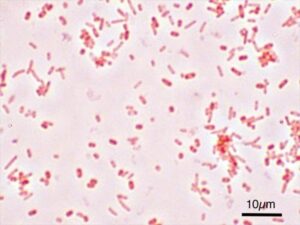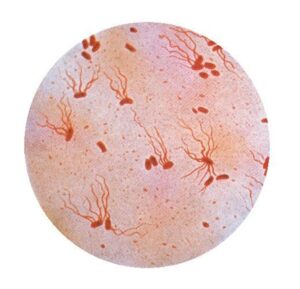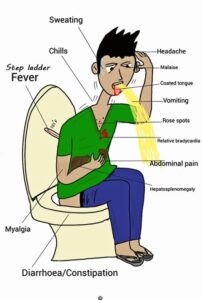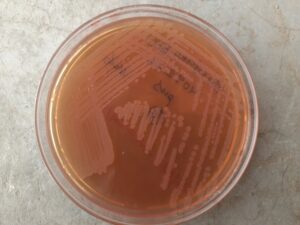Summary
Salmonella Typhi is a Gram-negative, rod-shaped bacterium responsible for causing typhoid fever, a severe systemic illness. It is part of the Enterobacteriaceae family and is exclusively adapted to humans. Transmission occurs primarily through ingestion of contaminated food or water. Symptoms of typhoid fever include high fever, weakness, abdominal pain, headache, and, in some cases, a rash. Without treatment, the disease can be fatal. Vaccines are available for prevention, and antibiotics are used for treatment, although antibiotic resistance is a growing concern. S. Typhi is prevalent in areas with poor sanitation and limited access to clean water.
Staining and Microbiologic Features:
- A gram-negative rod that is a facultative anaerobe [1]

File:Salmonella Typhimurium Gram.jpg” by Y tambe is licensed under CC BY-SA 3.0
- Its exclusive reservoir is humans [2].
- S. typhi is a non lactose fermenting organism and produces H2S on TSI agar [3].
- It tests negative for oxidase. [3]
- It is a facultative intracellular pathogen (i.e., it can survive in host cells) [4].
- Salmonella typhi, in contrast to Shigella, is considered acid-sensitive, making it susceptible to the acidic conditions of the stomach. Consequently, it requires a high infective dose to initiate an infection in the intestines [5].
- Due to the absence of tryptophanase production, S. Typhi cannot convert tryptophan into indole, resulting in a negative result when tested for indole [6].
- Some strains of S.typhi can also utilize citrate [6].
- In contrast to Shigella infection, antibiotic therapy in treating Shigella infection prolongs the duration of S.typhi excretion in feces [5].
Virulence and Pathogenicity:
- Salmonella can also utilize M cells, specialized epithelial cells in the gastrointestinal tract, to facilitate entry into the mucosal tissue and initiate infection [7].
- Salmonella-secreted invasion proteins (Ssps) and a type III secretion system help the bacterium to release its pathogenic proteins into the host cells [7].
- Capsule and Vi capsular antigen of salmonella typhi enhances its ability to resist phagocytosis [2].
- It produces siderophores that help it to extract iron from the host [2].
- S. typhi is a motile pathogen as it has flagella and, consequently, tests positive for the H antigen [2].

Microscopic Typhoid Fever” by Kat M. Research is licensed under CC BY-SA 2.0
Transmission:
- Transmission occurs through the fecal-oral route [2]
- Consumption of contaminated food and water
Susceptible Groups:
- As the spleen plays a crucial role in clearing encapsulated bacteria from the bloodstream, patients with splenectomy or functional asplenia (e.g., in sickle cell disease) are at elevated risk of infection.
- As S. typhi is acid-labile, proton pump inhibitors (PPIs) can lower stomach acid levels and potentially increase the risk of infection [8].
Diseases and Complications:
- Typhoid Fever: The patient can present with fever, abdominal pain, hepatosplenomegaly, bradycardia and pulse-temperature dissociation [5,9]. Some patients can also develop rose spots on the abdomen. The WBC count of the affected patient can be within the normal range or below.

Typhoid patient” by Armanjain011 is licensed under CC BY-SA 4.0
- In the affected patient, the white blood cell (WBC) count may either be within the normal range or below it [9]. Untreated patients can develop ulceration and bleeding in the gastrointestinal tract [5].
- Some individuals may become chronic carriers, where Salmonella Typhi persists in the gallbladder [4].
- It can also result in sepsis and osteomyelitis in some patients [4].
Diagnostic Testing:
- Culture of specimen obtained from blood or urine [4]

Salmonella growth on MacConkey medium” by Ajay Kumar Chaurasiya is licensed under CC BY-SA 4.0.
- Serological tests for detecting Salmonella infection include agglutination tests, tube dilution agglutination tests (such as the Widal test), or Nucleic Acid Amplification Tests (NAATs) [10].
References:
1 Jawetz, Melnick, & Adelberg’s Medical Microbiology Twenty-Seventh Edition (page no: 50)
2 CMMRS edition 6, 2016-17 (page no: 84)
3 First Aid for USMLE step 1, 2021 edition (page no: 141)
4 CMMRS edition 6, 2016-17 (page no: 85)
5 First Aid for USMLE step 1, 2021 edition (page no: 144)
6 Sketchy Micro
7 Medical Microbiology by Patrick R. Murray Ph.D., Ken Rosenthal Ph.D., Michael A. Pfaller MD, 8th edition (page no: 259)
8 USMLE Step 1 Lecture Notes: Microbiology / Immunology (Kaplan Medical) 2020 edition (page no: 253)
9 Jawetz, Melnick, & Adelberg’s Medical Microbiology Twenty-Seventh Edition (page no: 240)
10 Jawetz, Melnick, & Adelberg’s Medical Microbiology Twenty-Seventh Edition (page no: 241)

